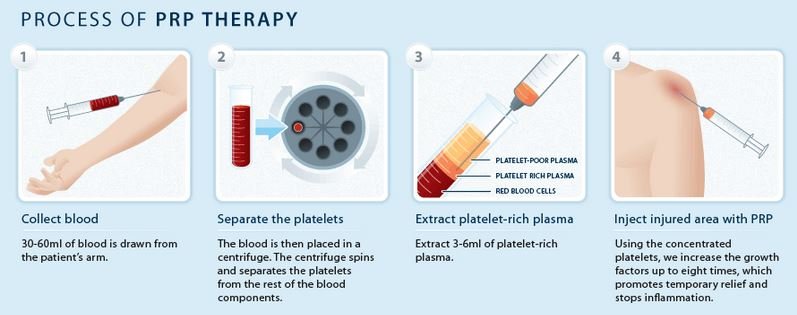Platelet Rich Plasma – A Novel Therapy for Alopecia Management
Platelet Rich Plasma
Alopecia or thinning of hair is a very serious beauty concern for both male and female in the present century. Every day we shed almost 50 to 100 hairs naturally, but it cannot hamper the density of hair present in the scalp if the subsequent hair growth cycle is continued and replaced the hair follicles (1).
Hair loss is a universal disorder. Won-Soo Lee, and Hae-Jin Lee, reported in their report that up to 73% among the general population, both men and women reported common baldness incidence in Asian countries (2). However, hair loss in younger generation can have significant psychological manifestations.
Naturally hair growth process
Natural hair is growing from follicles which are present beneath the scalp skin. The hairs taking their nourishment for growth from the blood vessels present inside the follicles. The duration of the lifespan of a hair depends on four stages, which anagen, catagen, exogen and telogen.
Anagen is a growing phase and the duration may vary from two to seven years and the length of the hair also depends upon this phase. In catagen phase, the hair follicle becomes shrunk and separate from the dermal attachment. In exogen phase the hair shedding occurs due to complete separation of hair follicles from the scalp layer and in telogen, minimum number of hairs are reached in this phase.
In this phase the old hair is taking rest and new hair starts to grow. The major growth factors concerned for the development of the hair follicle are insulin 1-like growth factor, fibroblast growth factor (FGF), epidermal growth factor (EGF ), and vascular endothelial growth factor (VEGF). The deficiency of these growth factors can shorten the duration of anagen and hairs enter the resting phase earlier, which cause the weaker biologic structure of hair and easy shedding. (3,4)
The Role of Platelet Rich Plasma (PRP)
The Platelet Rich Plasma (PRP) has a very prominent role in novel hair re-growth therapy, as Parsley WM, Perez-Meza D revealed in their review paper that Platelets discharge a great quantity of platelet-derived growth factor (PDGFaa, PDGFbb, and PDGFab), EGF,transforming growth factor beta (TGFβ1 and β2), and VEGF.
Platelet Rich Plasma Therapy (PRP), is applicable for any type of hair loss may be caused by hereditary tendency, hormonal imbalance, trauma or chemotherapy, as this therapy can perceptibly stimulate resting hair follicles and promote them to start growing again (4, 5).
Clinical and preclinical research on Platelet Rich Plasma
In 2005, the researcher Uebel conducted a clinical research to show the efficacy of the PRP. The trial data support that PRP enhanced the implanted hair root grafting by localized application after 1 year of the application of PRP.
Researcher Li et al. conducted one animal study on mice model, at showed that PRP injection increased the proliferation of dermal papilla (DP) cells. Dermal papilla (DP) regulates hair follicle development and growth. DP also up regulates both FGF-7 ( fibroblast growth factors 7) and beta-catenin, which act as effective stimuli of hair development. (4)
The PRP procedure
For PRP therapy, the required Platelet Rich Plasma is acquired from the patient’s own blood. For collection of PRP, blood need to processing under an automated centrifuge and the collected PRP is injected subcutaneously into the area of baldness (Marx RE, 2001). It is a potential therapy applicable for both men or women who suffer with hair loss.(4)

Both human and animal studies reported prompted the use of a novel modality of PRP which has shown beneficial effect for improvement in the function of the hair follicle and promotion of hair growth. Platelet Rich Plasma therapy is safe, inexpensive, and non-allergic and it emerges to be a valuable adjuvant in the management of hair loss.(4,5)
References
- Hair loss (2015); Mayo Clinic Staff; Retrieve from: http://www.mayoclinic.org/diseases-conditions/hair-loss/basics/causes/con-20027666
- Won-Soo Lee, and Hae-Jin Lee, (2012); Characteristics of Androgenetic Alopecia in Asian; Ann Dermatol. 2012 Aug; 24(3): 243–252; Retrieve from: http://www.ncbi.nlm.nih.gov/pmc/articles/PMC3412231/
- The Hair Growth Cycle; Retrieve from: http://www.viviscal.com/hair-growth-cycle
- Nitin D Chaudhari, Yugal K Sharma, Kedar Dash, and Palak Deshmukh (2012); Role of Platelet-rich Plasma in the Management of Androgenetic Alopecia; Int J Trichology. 2012 Oct-Dec; 4(4): 291–292; Retrieve from: http://www.ncbi.nlm.nih.gov/pmc/articles/PMC3681120/
- A bloody cure for baldness? Vampire HAIR lift – which uses same technology as facial beloved by Kim Kardashian – uses your own blood to lengthen and strengthen locks (2014); BIANCA LONDON FOR MAILONLINE; Retrieve from: http://www.dailymail.co.uk/femail/article-2764957/One-Kim-Kardashian-Vampire-HAIR-lift-uses-technology-gruesome-facial-beloved-reality-star-uses-blood-lengthen-strengthen-locks.html
